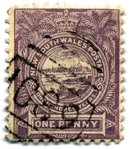Postage stamps and postal history of New South Wales
|
|
This is a survey of the postage stamps and postal history of New South Wales, a former British colony now part of Australia.
New South Wales was the first part of Australia to be settled by Europeans, and the first to operate a postal service, which in 1803 was carrying letters between Sydney and Parramatta for a 2p charge. In 1809 a collecting office in Sydney was established to receive mail from passing ships, and in 1825 the postal service was expanded. Mail coach service began in 1830, and in 1835 a new Postage Act superseded the 1825 statute and set rates based on weight and distance travelled.
The postmaster of the time, James Raymond, was in communication with Rowland Hill in England and worked to encourage the prepayment of letters in NSW. In 1838, Raymond introduced envelopes embossed with the seal of the colony, and available for local mail for 1 1/4 pence apiece instead of the 2p charged letters paid for in cash. They are thus regarded as precursors of the Penny Black. However, the envelopes were not popular, and in 1841 Raymond was unable to develop official interest in postage stamps for the colony.
In 1842 regular mail service was carried by steamer between Melbourne and Sydney, and the first mail packet from Britain arrived in 1844. An act of 1848 reformed the postal system and authorized the use of stamps; the first stamps appeared on 1 January 1850. They were locally produced, and depicted a scene of Sydney and it harbor, thus becoming known as the "Sydney Views". The 1p, 2p, and 3p stamps were separately engraved, and then re-engraved and retouched over the next year, yielding dozens of varieties.
In 1851 the colony switched to a more conventional design, a profile of Queen Victoria wearing a laurel wreath, first in a somewhat crude rendition, then a better one in 1853. The colony also took the unusual step of using paper watermarked with the denomination, a practice that resulted in a number of mismatches between watermark and printed denomination that are rare and highly prized today.
In 1854 the colony issued 6p and 1sh stamps printed locally, from plates engraved by Perkins Bacon in England. These were large square stamps with the standard profile of Victoria wearing a diadem, framed with a hexagon and octagon respectively. The designs were reused for 5p and 8p in 1855. In 1856 a Perkins Bacon design was also adopted for the lower values as well. The inking of all these was highly variable, and there are dozens of distinct color varieties. The use of perforation began in 1860; unfortunately for collectors, the stamps were very closely spaced, the perforating process not well-controlled, and it is unusual to find stamps from before 1899 where the perforation does not touch or cut into the design on one or more sides.
Stamp_NSW_1891_3p-500px.jpg
New South Wales stamp, 1891 3p green
1856 3p green; a perf. 10 version printed in 1891
The first 5-shilling stamp was issued in 1861, and it was notable for being a round design resembling a medallion. In 1861, new designs were created by De La Rue and printed both in London and the colony.
In 1871 a watermark reading "NSW" surmounted by a crown began to replace the numerals, and in 1885 a need for high-values prompted the overprinting of 5sh, 10sh, and one-pound revenue stamps with "POSTAGE".
New South Wales celebrated its 100th anniversary in 1888 with an issue of what is widely considered to be the first commemorative stamps. The set of eight, each with a different design, were all inscribed "ONE HUNDRED YEARS". Among the designs were a view of Sydney, an emu, Captain Cook, a lyrebird, and a kangaroo. The 20sh value included portraits of both Arthur Phillip the first governor, and the then-governor Lord Carrington.
A 2 1/2p stamp depicting an allegorical figure of Australia appeared in 1890, while 1/2p, 7 1/2p, and 12 1/2p values were produced in 1891 as surcharges on existing stamps.
Stamp_NSW_1897_2.5p-500px.jpg
New South Wales stamp, 1899 2.5p dkbl
1899 reissue in dark blue of 1897 2 1/2p Diamond Jubilee stamp
In 1897 two early semi-postal stamps were issued, paying 1p and 2 1/2p rates, but sold for 1sh and 2sh6p respectively, the additional proceeds going to a Consumptives' Home. In the same year a set of three stamps marked Victoria's Diamond Jubilee.
The formation of the Commonwealth had no immediate effect on the NSW postal system, but the systems gradually merged during the 1900s. In 1903 a 9p stamp in two colors (brown and blue) was inscribed "COMMONWEALTH" and mentioned the initials of each member along with its year of founding. In 1905 the stamps began to be printed on paper watermarked with a crown and the letter "A", with reprintings of existing designs occurring into 1910.
In 1913 the stamps of New South Wales were superseded by those of Australia; see stamps and postal history of Australia.
Most of the stamps of New South Wales are readily available today, but it is somewhat complex to collect; there are a dozen types of watermarks, multiple perforations, and numerous color shades. While the Scott catalog distinguishes about 200 major types, it calls out many more minor varieties, and the Stanley Gibbons catalog totals some 400 distinct varieties.


